Study on Aided Optical Alignment by Programmable Spots Array Generated by Off-Axis Parabolic Phase Based on LCoS-SLM
Abstract
:1. Introduction
2. Virtual OAP Mirror Based on LCoS-SLM
2.1. The General Scheme
2.2. Modeling and Simulation
2.3. Optical System Configuration
3. Phase Modulation Characteristic Calibration and Compensation of LCoS-SLM
4. Multi-Beam Array Generation and Optical Alignment Experiment
4.1. Multi-Beam Array Generation
4.2. Optical Alignment
5. Conclusions
Author Contributions
Funding
Acknowledgments
Conflicts of Interest
References
- Gao, H.; Xu, F.; Liu, J.; Dai, Z.; Zhou, W.; Li, S.; Yu, Y.; Zheng, H. Holographic three-dimensional virtual reality and augmented reality display based on 4k-spatial light modulators. Appl. Sci. 2019, 9, 1182. [Google Scholar] [CrossRef] [Green Version]
- Yang, Q.; Zou, J.; Li, Y.; Wu, S.-T. Fast-response liquid crystal phase modulators with an excellent photostability. Crystals 2020, 10, 765. [Google Scholar] [CrossRef]
- Shimizu, Y.; Matsuno, Y.; Chen, Y.-L.; Matsukuma, H.; Gao, W. Design and testing of a micro-thermal sensor probe for nondestructive detection of defects on a flat surface. Nanomanuf. Metrol. 2018, 1, 45–57. [Google Scholar] [CrossRef]
- Gao, W.; Haitjema, H.; Fang, F.Z.; Leach, R.; Cheung, C.; Savio, E.; Linares, J.-M. On-machine and in-process surface metrology for precision manufacturing. CIRP Ann. 2019, 68, 843–866. [Google Scholar] [CrossRef] [Green Version]
- Wei, Z.; Jianfeng, L.; Funian, L. Study on Compensation Relationships Among the Elements in Off-axis Three-mirror System. Acta Photonica Sin. 2005, 34, 1160. [Google Scholar] [CrossRef]
- Huang, Y.; Li, L.; Cao, Y. Computer-Aided Alignment for Space Telescope Optical System. In Proceedings of the 2nd International Symposium on Advanced Optical Manufacturing and Testing Technologies: Advanced Optical Manufacturing Technologies, Xi’an, China, 9 June 2006. [Google Scholar]
- Kim, Y.; Yang, H.S.; Kim, S.W.; Lee, Y.W. Alignment of off-axis optical system with multi mirrors using derivative of zernike polynomial coefficient. Proc. SPIE- Int. Soc. Opt. Eng. 2009, 7433, 74330C. [Google Scholar] [CrossRef]
- Li, S.; Zhang, J.; Liu, W.; Liang, H.; Xie, Y.; Li, X. The methods and experiments of shape measurement for off-axis conic aspheric surface. Materials 2020, 13, 2101. [Google Scholar] [CrossRef]
- Batchko, R.G.; Szilagyi, A. Fluidic Lens with Manually-Adjustable Focus. U.S. Patent No. 7,697,214, 13 April 2010. [Google Scholar]
- Zhao, C.; Zehnder, R.; Burge, J.H.; Martin, H.M. Testing an off-axis parabola with a cgh and a spherical mirror as null lens. In Optics & Photonics; International Society for Optics and Photonics: Bellingham, WA, USA, 2005; Volume 5869, pp. 586911–586912. [Google Scholar]
- Gao, Y.; Chen, X.; Chen, G.; Tan, Z.; Chen, Q.; Dai, D.; Zhang, Q.; Yu, C. Programmable spectral filter in c-band based on digital micromirror device. Micromachines 2019, 10, 163. [Google Scholar] [CrossRef] [Green Version]
- Huang, S.-J.; Wang, S.-Z.; Yu, Y.-J. Computer Generated Holography Based on Fourier Transform Using Conjugate Symmetric Extension. 2009. Available online: iphy.ac.cn (accessed on 21 July 2008).
- Ge, L.; Duelli, M.; Cohn, R.W. Enumeration of illumination and scanning modes from real-time spatial light modulators. Opt. Express 2000, 7, 403–416. [Google Scholar] [CrossRef] [Green Version]
- Li, R.; Cao, L. Progress in phase calibration for liquid crystal spatial light modulators. Appl. Sci. 2019, 9, 2012. [Google Scholar] [CrossRef] [Green Version]
- Otón, J.; Ambs, P.; Millán, M.S.; Pérez-Cabré, E. Multipoint phase calibration for improved compensation of inherent wavefront distortion in parallel aligned liquid crystal on silicon displays. Appl. Opt. 2007, 46, 5667–5679. [Google Scholar] [CrossRef] [PubMed]
- Villalobos-Mendoza, B.; Granados-Agustín, F.S.; Aguirre-Aguirre, D.; Cornejo-Rodríguez, A. Obtaining the curve “phase shift vs gray level” of a spatial light modulator holoeye lc2012. J. Phys. Conf. Ser. 2015, 605, 012016. [Google Scholar] [CrossRef]
- Nie, Y.; Yang, L.; Liu, J. Ultrafast Optical Signal Pulse Descending Time Controlling with Deformable Mirror and Spatial Light Modulators. J. Phys. Conf. Ser. 2016, 679, 012046. [Google Scholar]
- Xia, J.; Chang, C.; Chen, Z.; Zhu, Z.; Zeng, T.; Liang, P.Y.; Ding, J.; Xia, J.; Chang, C.; Chen, Z. Pixel-addressable phase calibration of spatial light modulators: A common-path phase-shifting interferometric microscopy approach. J. Opt. 2017, 19, 125701. [Google Scholar] [CrossRef]
- Pei, L.; Huang, D.; Fan, W.; Cheng, H.; Li, X. Phase-only optically addressable spatial-light modulator and on-line phase-modulation detection system. Appl. Sci. 2018, 8, 1812. [Google Scholar] [CrossRef] [Green Version]
- Zhang, X.; Fang, F.Z.; Wu, Q.; Liu, X.; Gao, H. Coordinate transformation machining of off-axis aspheric mirrors. Int. J. Adv. Manuf. Technol. 2013, 67, 2217–2224. [Google Scholar] [CrossRef]
- Engström, D.; Persson, M.; Bengtsson, J.; Goksör, M. Calibration of spatial light modulators suffering from spatially varying phase response. Opt. Express 2013, 21, 16086. [Google Scholar]
- Lu, Q.; Sheng, L.; Zeng, F.; Gao, S.; Qiao, Y. Improved method to fully compensate the spatial phase nonuniformity of lcos devices with a fizeau interferometer. Appl. Opt. 2016, 55, 7796. [Google Scholar] [CrossRef]
- Hermerschmidt, A.; Osten, S.; Krüger, S.; Blümel, T. Wave Front Generation Using a Phase-Only Modulating Liquid-Crystal-Based Micro-Display With Hdtv Resolution. In Adaptive Optics for Laser Systems and Other Applications; International Society for Optics and Photonics: Bellingham, WA, USA, 2007; p. 65840E. [Google Scholar]
- Martínez, F.J.; Márquez, A.; Gallego, S.; Ortuño, M.; Francés, J.; Beléndez, A.; Pascual, I. Electrical dependencies of optical modulation capabilities in digitally addressed parallel aligned liquid crystal on silicon devices. Opt. Eng. 2014, 53, 067104. [Google Scholar] [CrossRef] [Green Version]
- Lizana, A.; Martín, N.; Estapé, M.; Fernández, E.; Moreno, I.; Márquez, A.; Iemmi, C.; Campos, J.; Yzuel, M.J. Influence of the incident angle in the performance of liquid crystal on silicon displays. Opt. Express 2009, 17, 8491. [Google Scholar] [CrossRef] [Green Version]
- Márquez, A.; Martínez-Guardiola, F.J.; Francés, J.; Gallego, S.; Pascual, I.; Beléndez, A. Combining average molecular tilt and flicker for management of depolarized light in parallel-aligned liquid crystal devices for broadband and wide-angle illumination. Opt. Express 2019, 27, 5238–5252. [Google Scholar] [CrossRef] [PubMed]
- Fukuchi, N.; Ye, B.; Igasaki, Y.; Yoshida, N.; Kobayashi, Y.; Hara, T. Oblique-incidence characteristics of a parallel-aligned nematic-liquid-crystal spatial light modulator. Opt. Rev. 2005, 12, 372–377. [Google Scholar] [CrossRef]
- Cao, Z.; Mu, Q.; Hu, L.; Liu, Y.; Peng, Z.; Xuan, L. Reflective liquid crystal wavefront corrector used with tilt incidence. Appl. Opt. 2008, 47, 1785–1789. [Google Scholar] [CrossRef] [PubMed]
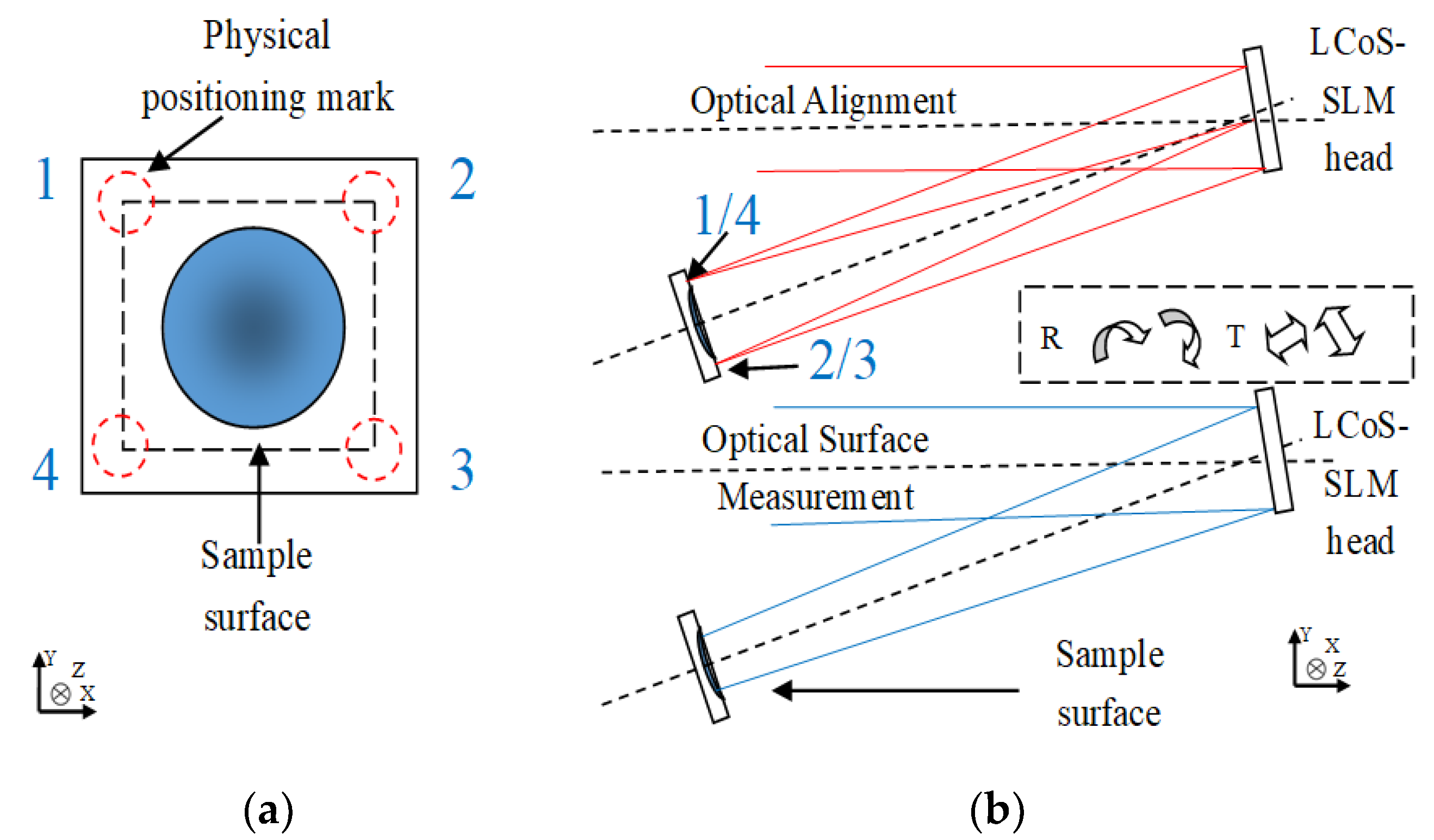
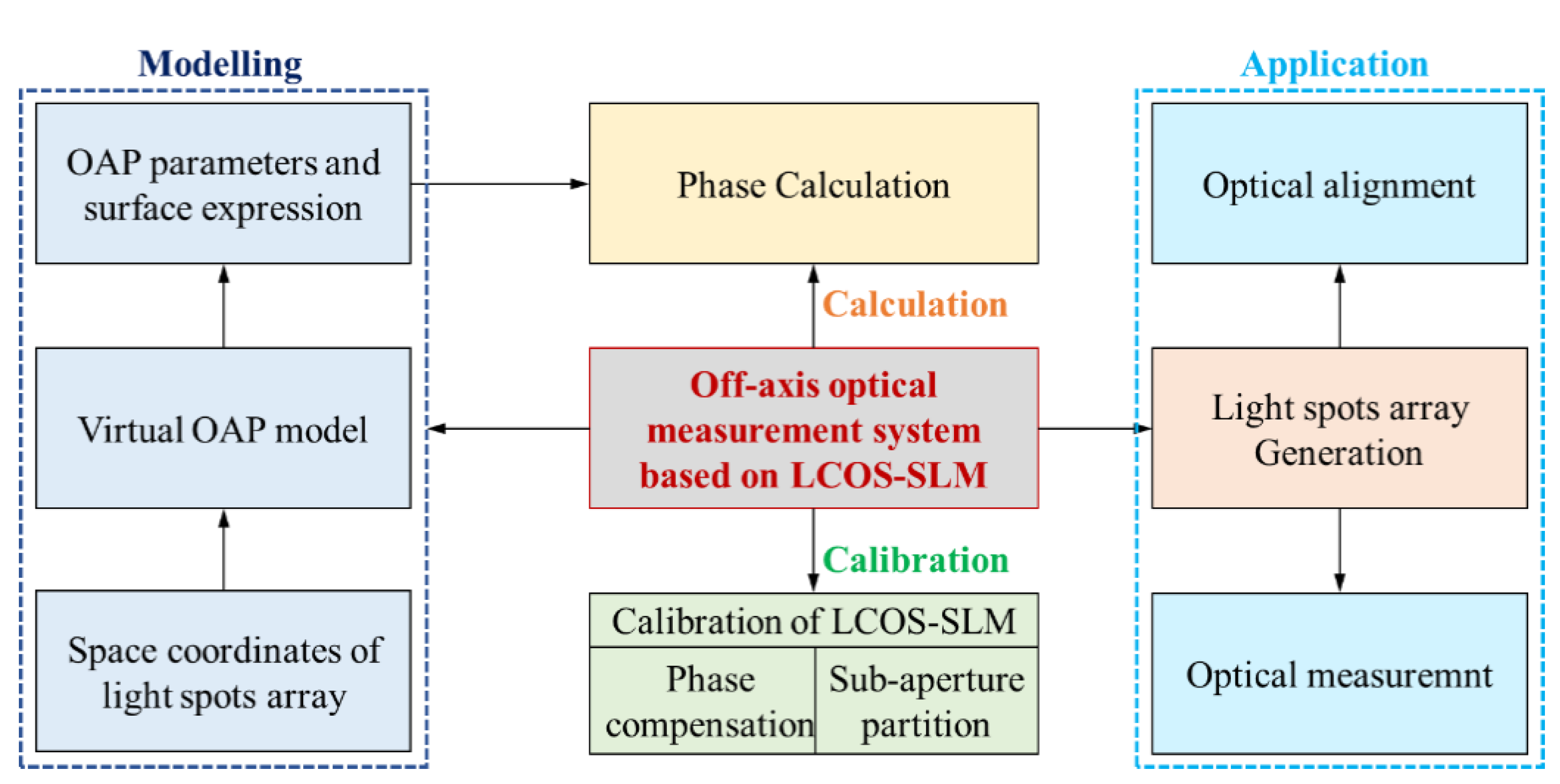
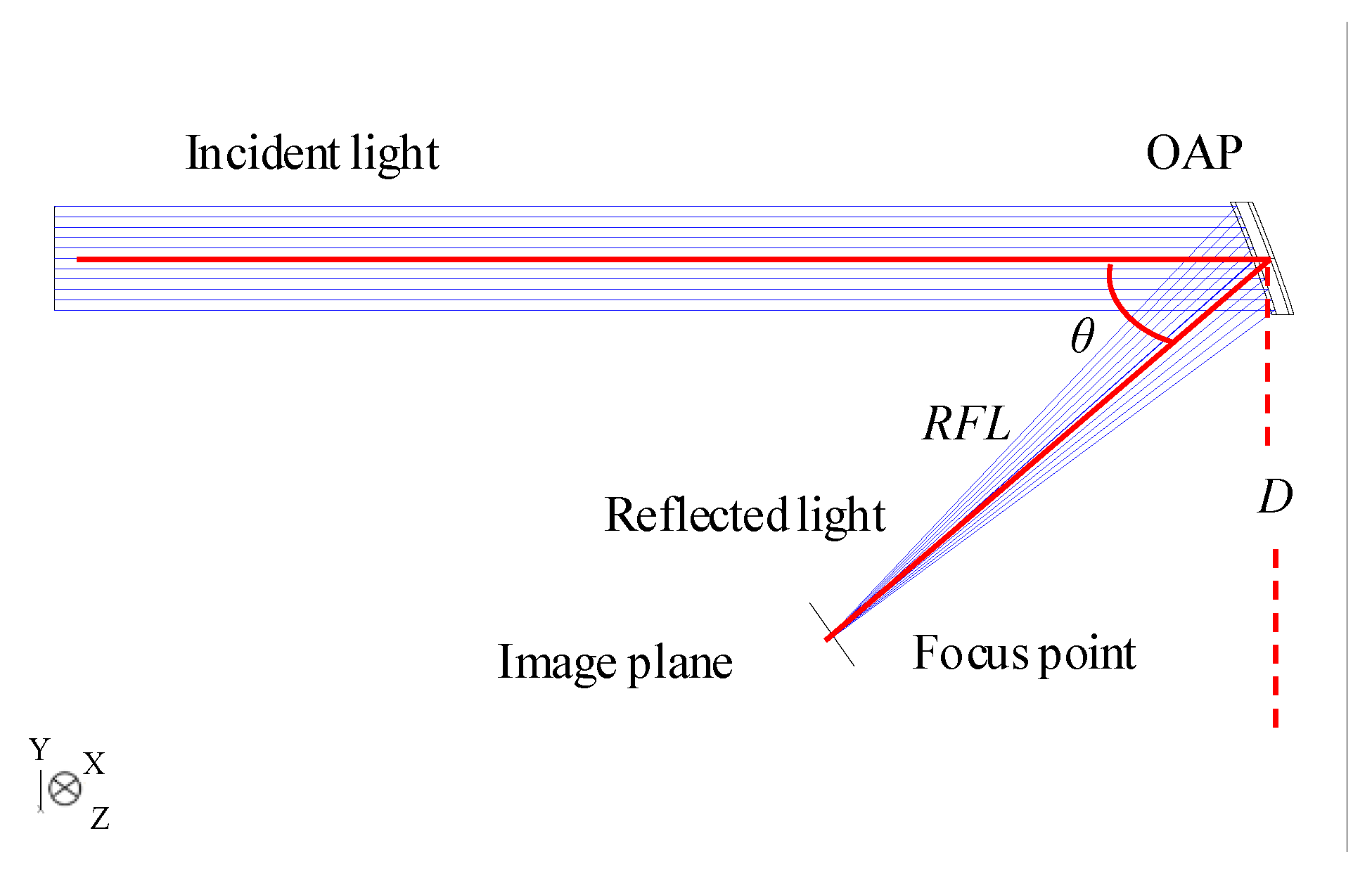


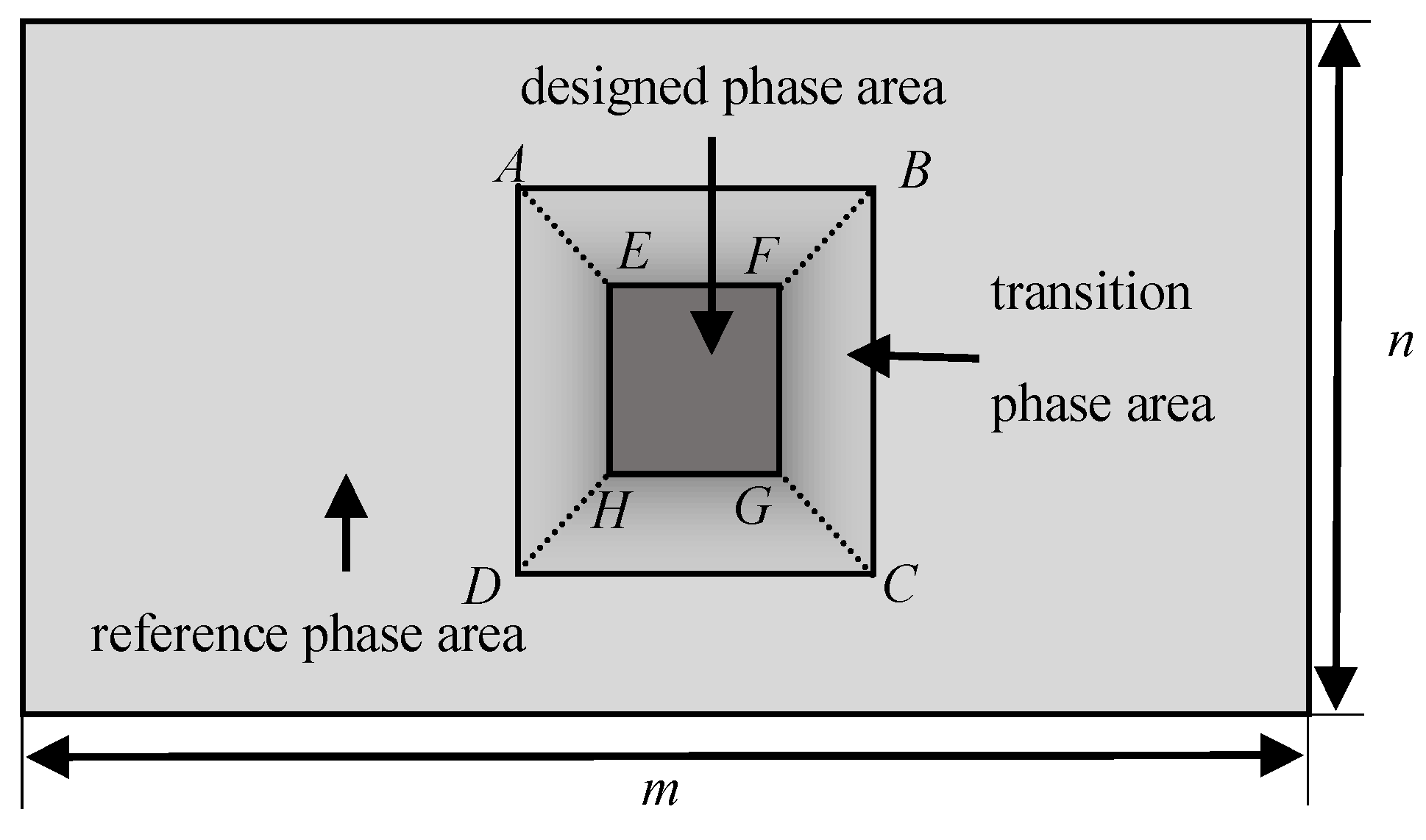


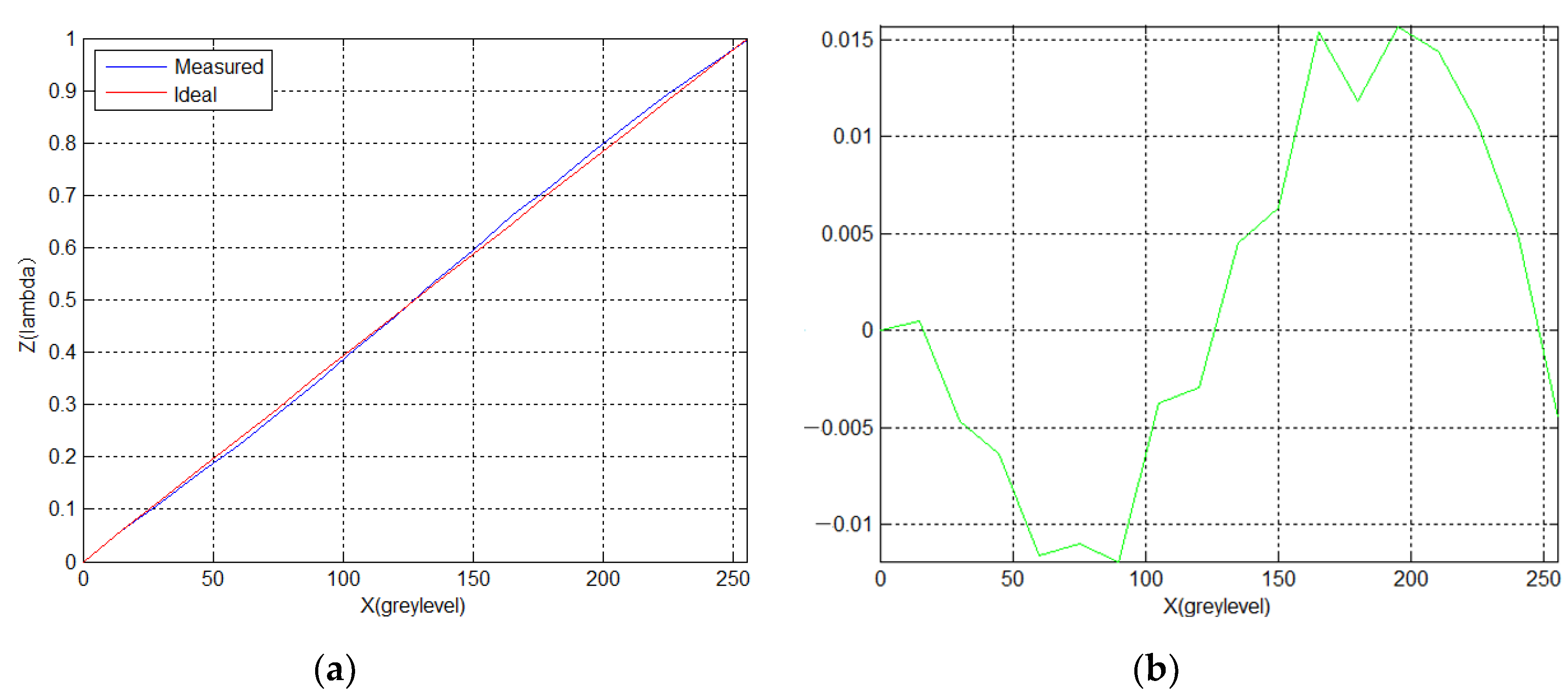
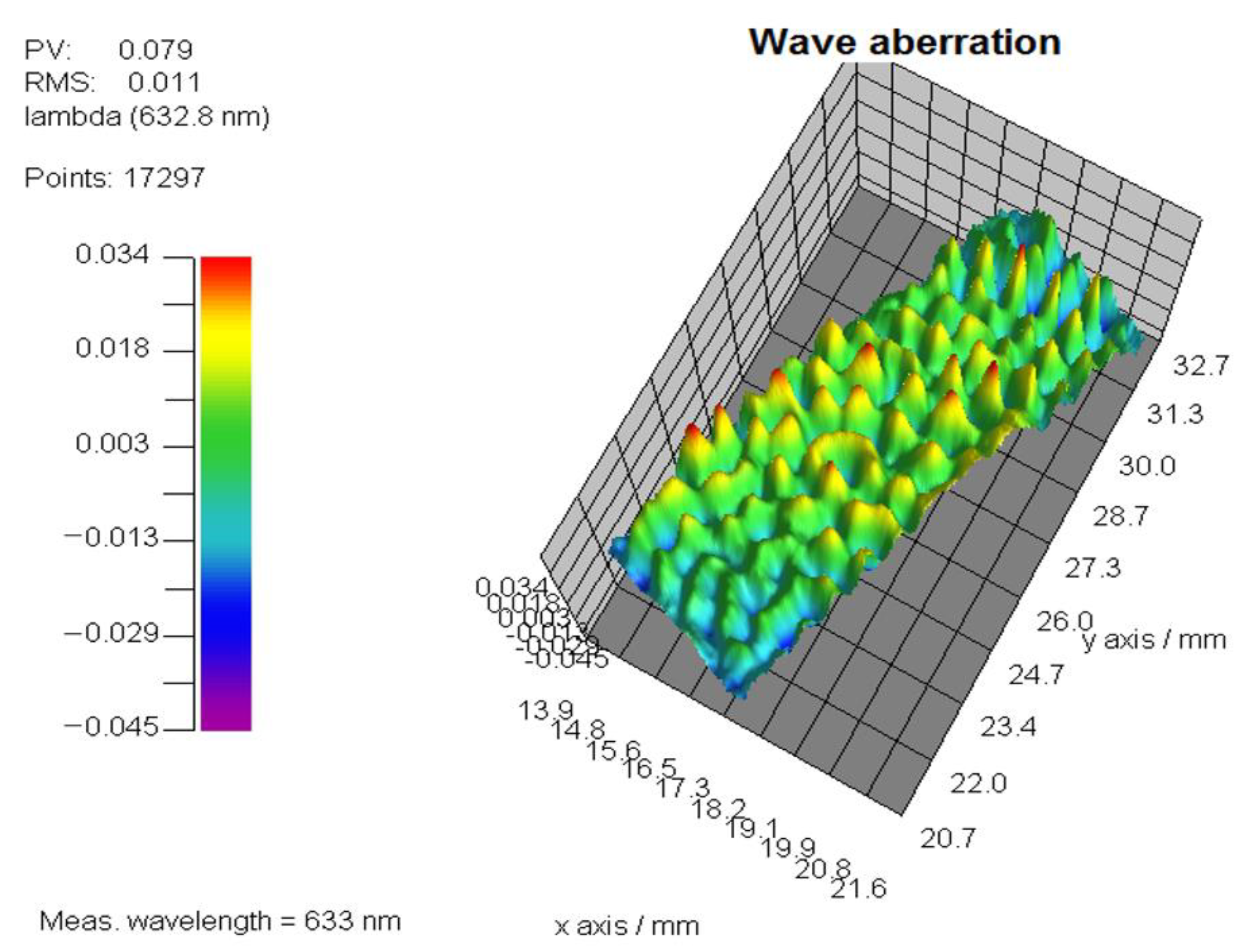


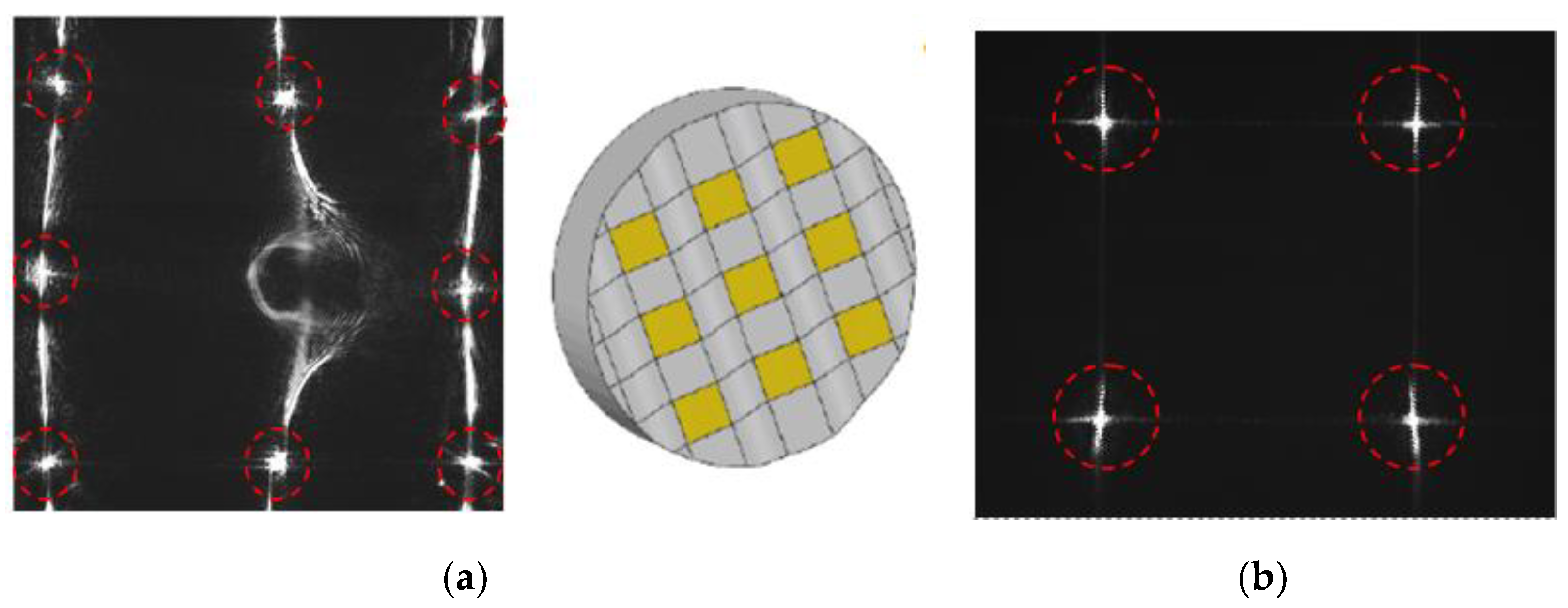
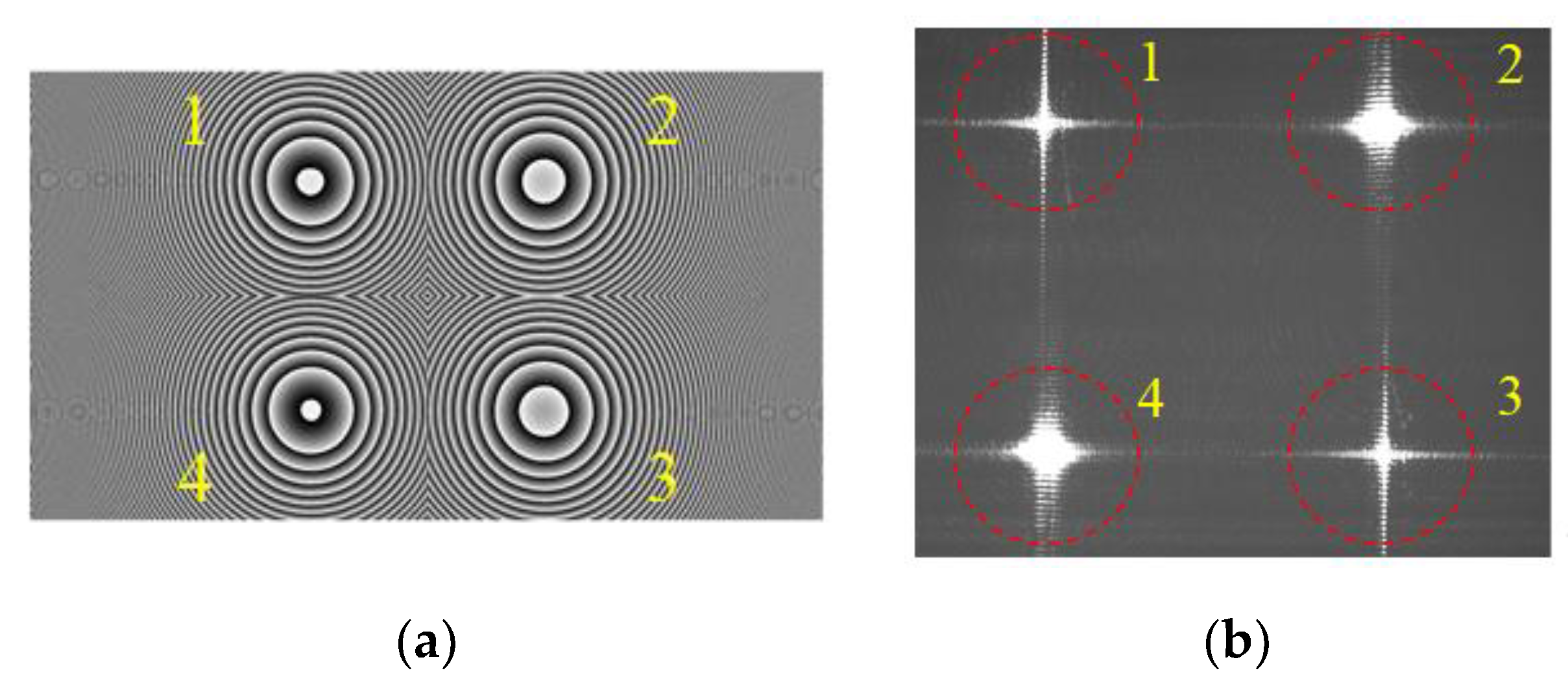


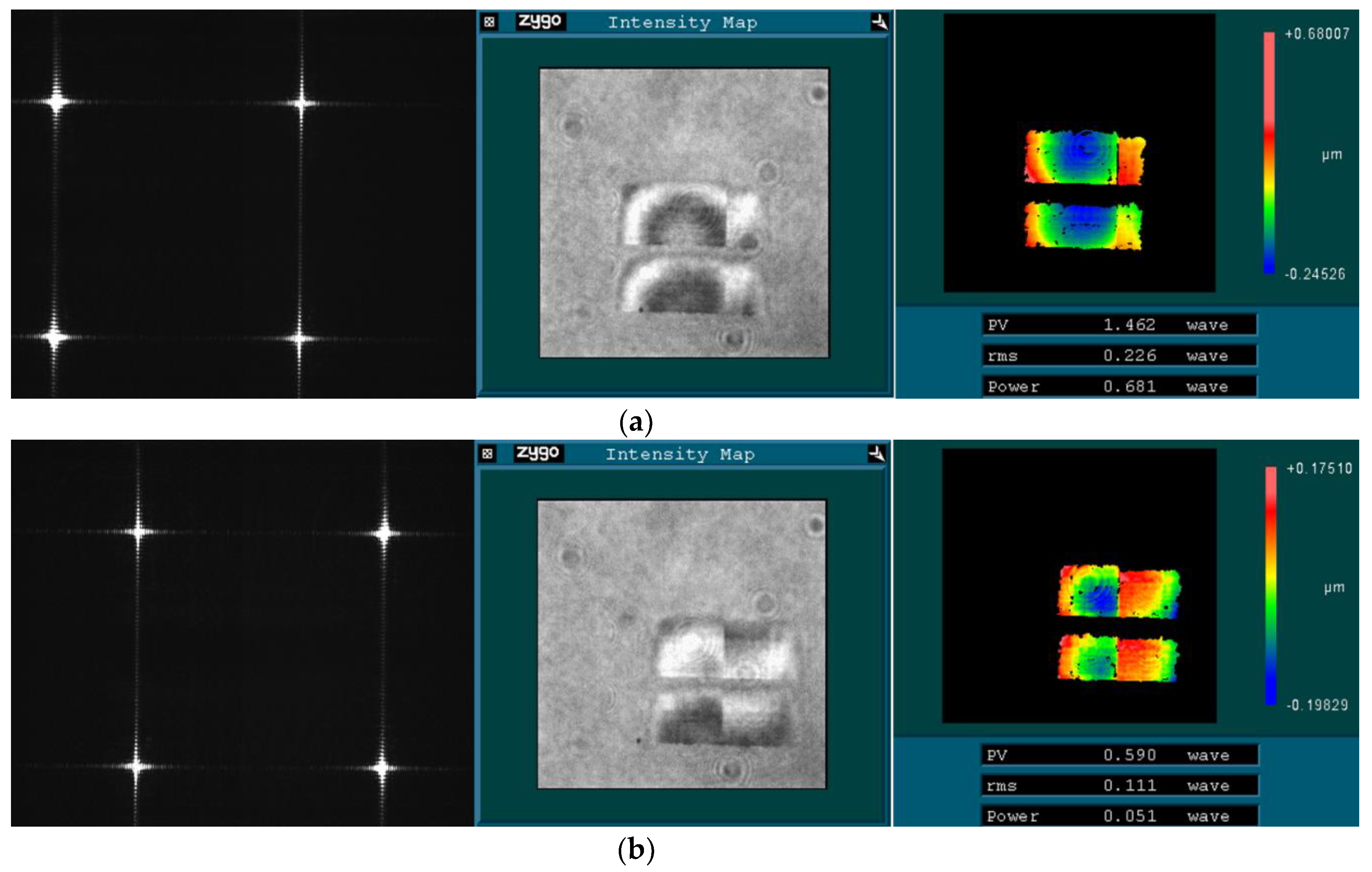
Publisher’s Note: MDPI stays neutral with regard to jurisdictional claims in published maps and institutional affiliations. |
© 2020 by the authors. Licensee MDPI, Basel, Switzerland. This article is an open access article distributed under the terms and conditions of the Creative Commons Attribution (CC BY) license (http://creativecommons.org/licenses/by/4.0/).
Share and Cite
Zeng, Z.; Li, Z.; Fang, F.; Zhang, X. Study on Aided Optical Alignment by Programmable Spots Array Generated by Off-Axis Parabolic Phase Based on LCoS-SLM. Appl. Sci. 2020, 10, 8382. https://doi.org/10.3390/app10238382
Zeng Z, Li Z, Fang F, Zhang X. Study on Aided Optical Alignment by Programmable Spots Array Generated by Off-Axis Parabolic Phase Based on LCoS-SLM. Applied Sciences. 2020; 10(23):8382. https://doi.org/10.3390/app10238382
Chicago/Turabian StyleZeng, Zhen, Zexiao Li, Fengzhou Fang, and Xiaodong Zhang. 2020. "Study on Aided Optical Alignment by Programmable Spots Array Generated by Off-Axis Parabolic Phase Based on LCoS-SLM" Applied Sciences 10, no. 23: 8382. https://doi.org/10.3390/app10238382



